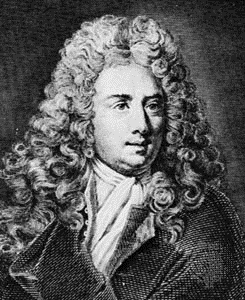Antoine Galland facts for kids
Quick facts for kids
Antoine Galland
|
|
|---|---|
 |
|
| Born | 4 April 1646 Rollot, Picardy, Kingdom of France
|
| Died | 17 February 1715 (aged 68) |
| Occupation |
|
| Years active | 1670–1715 |
| Known for | First European translator of One Thousand and One Nights |
|
Notable work
|
Les mille et une nuits |
Antoine Galland (born April 4, 1646 – died February 17, 1715) was a French scholar. He studied the East and was also an archaeologist. He is most famous for being the first European to translate One Thousand and One Nights. He called his version Les mille et une nuits.
His translation of these famous tales came out in twelve books. This happened between 1704 and 1717. His work greatly influenced later European stories. It also changed how people viewed the Islamic world. Some experts believe that a big change in literature, called Romanticism, began when his translation was first read.
Contents
The Life and Work of Antoine Galland
Antoine Galland was born in a town called Rollot in Picardy, France. After finishing school, he studied Greek and Latin in Paris. He also started learning some Arabic.
Early Travels and Studies
In 1670, Galland joined the French embassy in Istanbul. He was chosen because he knew Greek very well. In 1673, he traveled to Syria and the Levant. There, he copied many old writings. He also sketched and sometimes took historical objects.
After a short visit back to France, Galland returned to the Levant in 1677. In 1679, he went on a third trip. This time, the French East India Company asked him to collect items for a royal collection. After this job, the government asked him to keep doing his research. He was given the title of "antiquary" to King Louis XIV. An antiquary is someone who studies old things.
During his long stays abroad, Galland learned a lot about Arabic, Turkish, and Persian. He also studied their literatures. When he finally returned to France, he helped other scholars.
Important Contributions
After a friend named d'Herbelot died in 1695, Galland continued his big book. It was called Bibliothèque orientale ("Oriental Library"). This book was a huge collection of facts about Islamic culture. It was mainly a translation of a large Arabic encyclopedia. The book was published in 1697. It greatly helped Europeans learn about the Middle East.
In 1704, Galland started publishing Les mille et Une Nuits. This book became very popular right away. It is still the main French translation of the tales. In 1709, he became a professor of Arabic at the Collège de France. He kept this job until he died in 1715.
Besides his famous translation, Galland also wrote other books. In 1694, he published a collection of wise sayings from Eastern cultures. In 1699, he translated an Arabic book about the history of coffee. His book about coffee was later translated into English in 1795.
Translating The Thousand and One Nights
Galland found an old book of The Tale of Sindbad the Sailor in Constantinople in the 1690s. In 1701, he published his French translation of it. People loved it! This success made him want to translate The Thousand and One Nights. He used a Syrian book from the 1300s or 1400s.
The first two books of his translation came out in 1704. The last book was published in 1717, after he had passed away.
He translated the first part of his work only from the Syrian book. But in 1709, he met a Christian man from Aleppo named Hanna Diab. Hanna told Galland fourteen more stories from his memory. Galland decided to add seven of these new tales to his version of the Nights.
Some of the most famous stories have a bit of a mystery around them. For example, there are no Arabic books of Aladdin and Ali Baba that are older than Galland's translation. These are sometimes called "orphan tales." Galland had heard these stories from Hanna Diyab.
Galland also changed his translation to fit what people liked at the time. The tales became popular partly because fairy stories were very trendy in France. His friend Charles Perrault had started this trend in the 1690s. Galland also wanted his translation to follow the writing rules of his time. Because of this, some people, like Richard Francis Burton, later said that Galland's version was a "delightful shortened and changed" story that didn't truly show the original Eastern tales.
His translation was very popular. It was quickly translated into many other European languages. These included English (1706), German (1712), Italian (1722), Dutch (1732), Russian (1763), and Polish (1768). His work led to many other stories that copied the style of Eastern tales in the 1700s.
Works
- Les paroles remarquables, les bons mots et les maximes des Orientaux (Remarkable Sayings, Good Words, and Maxims of the Orientals), 1694
- Contes et fables indiennes, de Bidpaï et de Lokman (Indian Tales and Fables, from Bidpai and Lokman)
- De l’origine et du progrès du café (On the Origin and Progress of Coffee)
- Le Voyage à Smyrne (The Journey to Smyrna), 2000
- Histoire d'Aladin ou la lampe merveilleuse (The Story of Aladdin or the Wonderful Lamp)
- Les Milles et une Nuits (The Thousand and One Nights)
See also
 In Spanish: Antoine Galland para niños
In Spanish: Antoine Galland para niños


